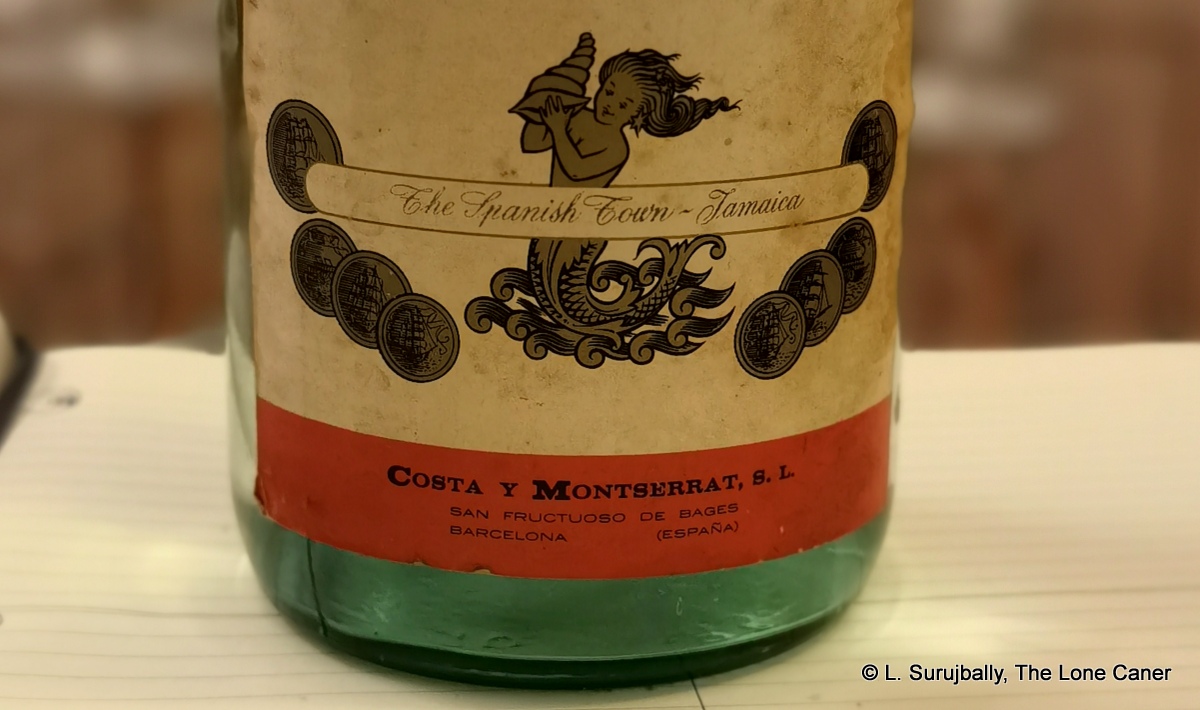 Rumaniacs Review R-159 | #1036
Rumaniacs Review R-159 | #1036
Few references exist to track down this aged bottle with stained yellow label and a description remarkably thin even for the Days of Ago when nobody cared. There is no distillery of make, no strength, no country of origin we can evaluate, nothing. It is a white rum, has pictures of several medals on it (or maybe those are those coins, like pieces of eight?) and the implication of the words “The Spanish Town – Jamaica” is that it hails from there. One does not even get the strength, though my hydrometer tested it out at 37.8%, so either it is 40% standard and then dosed down, or it’s clean and maybe 37%-38%.
As for the dating, the best source is a May 2019 auction listing on Whisky Auctioneer which suggests it’s from the 1960s, and which I have no grounds to seriously dispute – the label fonts and design and lack of provenance tend to support it, however thin that is. However, the auction site’s notation that it was produced in Spanish Town itself is not, I think, credible.
This leaves us with just the company, Costa Y Montserrat, SL from Barcelona in Spain. That most invaluable of resources, Pete’s Rum Labels, doesn’t provide any true data, but it does have another label, which suggests they were into the retailing of Jamaican-style rums which makes them an importer and blender, and the whole Spanish Town thing is just atmosphere and a cool label design but held no real truth (which is a shame, but okay…)
The company hails from the Catalan town of San Fructuosa de Bages (officially named Sant Fruitós de Bages), just to the north of Barcelona and the industrial estate of Manresa immediately to its west; wine has been made there for centuries. The Costa & Montserrat company refers to a famous Benedictine monastery of that name, built on a mountain nearby 1 However, that aside, what we have is the founding of the company in 1840, which made brandy in the early 20th century, and also fruit liqueurs in the late 1970s. I think it still exists, but under some other name I was unable to trace, and if it does, it’s not making rums any longer.
Colour – white
Strength – Tested at 37.8%
Nose – Astringent and sharp. It smells alcoholic (no pun intended), speaking more of raw ethanol than the easy lightness of a finely blended white cocktail rum. The puling strength is partly responsible for that of course. Also some rubber, minerally notes, green peas from a can, watermelon and a touch of sugar water.
Palate – Surprisingly there’s some brine here, again those canned peas (or, to be more precise, the water from that can), vague light sweet fruits such as papaya, watermelon and pears, but all very lacklustre, very much in the background. It’s like a dumbed down, weakly flavoured, underproofed vodka.
Finish – Almost nonexistent, really. Light sugar water, no burn, no tickle, no real taste.
Thoughts – If the intention of the label is to point towards Jamaica, I assure you that sampling it dispels any romantic notions that somehow I had picked up an undreamed-of pot-still Rum from the Cocktail Age. No such luck. It lacks strength, it lacks taste, it lacks any identifying characteristics of country or terroire, and is best seen as a pre-21st-century-Renaissance historical artefact that sheds light on rum’s development over the decades, rather than some kind of distant classic from a long vanished era. There’s a reason why it only fetched £31 on that auction. It’s a historian’s rum, not one for the bar crowd or connoisseurs of unappreciated rum, or even speculators.
(65/100) ⭐½
